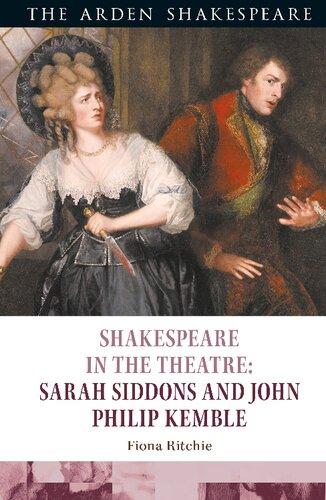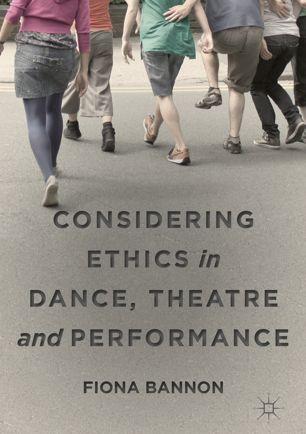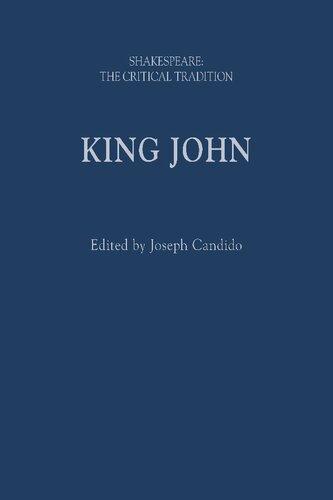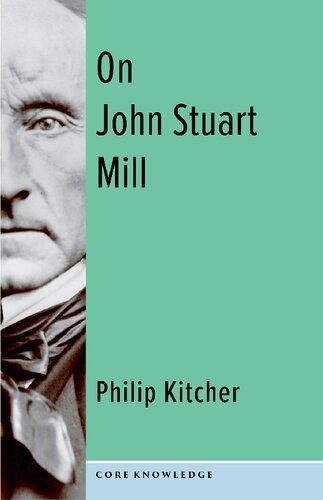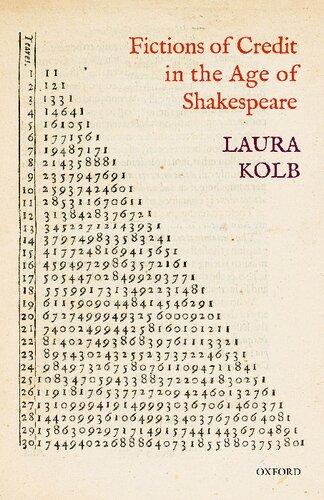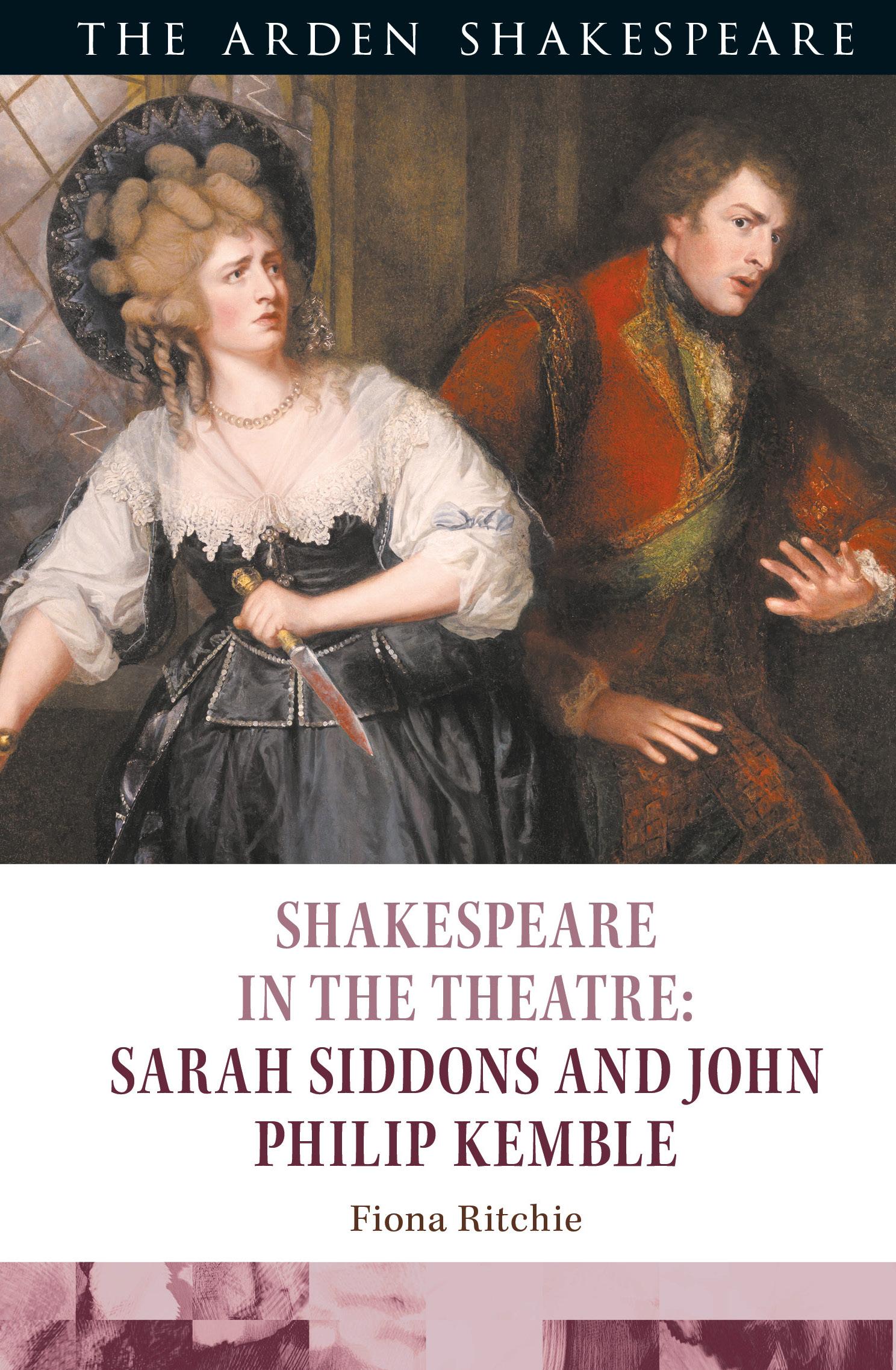Shakespeare in the Theatre: Sarah Siddons and John Philip
Kemble
Fiona Ritchie
THE ARDEN SHAKESPEARE
Bloomsbury Publishing Plc
50 Bedford Square, London, WC1B 3DP, UK
1385 Broadway, New York, NY 10018, USA
29 Earlsfort Terrace, Dublin 2, Ireland
BLOOMSBURY, THE ARDEN SHAKESPEARE and the Arden Shakespeare logo are trademarks of Bloomsbury Publishing Plc
First published in Great Britain 2023
Copyright © Fiona Ritchie, 2023
Fiona Ritchie has asserted her right under the Copyright, Designs and Patents Act, 1988, to be identified as the author of this work.
For legal purposes the Acknowledgements on p. ix constitute an extension of this copyright page.
Series design by Dani Leigh
Cover image: John Philip Kemble, Sarah Siddons (© Courtesy of the Garrick Club, London)
All rights reserved. No part of this publication may be reproduced or transmitted in any form or by any means, electronic or mechanical, including photocopying, recording, or any information storage or retrieval system, without prior permission in writing from the publishers.
Bloomsbury Publishing Plc does not have any control over, or responsibility for, any third-party websites referred to or in this book. All internet addresses given in this book were correct at the time of going to press. The author and publisher regret any inconvenience caused if addresses have changed or sites have ceased to exist, but can accept no responsibility for any such changes.
Library of Congress Cataloging-in-Publication Data
Names: Ritchie, Fiona, author.
Title: Sarah Siddons and John Philip Kemble / Fiona Ritchie.
Description: London ; New York : The Arden Shakespeare, 2022. | Series: Shakespeare in the theatre | Includes bibliographical references. Identifiers: LCCN 2022026610 | ISBN 9781350073289 (hardback) | ISBN 9781350352421 (paperback) | ISBN 9781350073302 (ebook) | ISBN 9781350073296 (epub) | ISBN 9781350073319
Subjects: LCSH: Siddons, Sarah, 1755-1831. | Kemble, John Philip, 1757-1823. | Theater--England--History--18th century. | Theater--England--History--19th century. | Shakespeare, William, 1564-1616--Stage history--1625-1800. | Shakespeare, William, 1564-1616--Stage history--1800-1950. | Shakespeare, William, 1564-1616--Dramatic production.
Classification: LCC PN2598.S5 R58 2022 | DDC 792.02/8092 [B]--dc23/eng/20220718 LC record available at https://lccn.loc.gov/2022026610
ISBN: HB: 978-1-3500-7328-9
ePDF: 978-1-3500-7330-2
eBook: 978-1-3500-7329-6
Series: Shakespeare in the Theatre
Typeset by Deanta Global Publishing Services, Chennai, India
To find out more about our authors and books visit www.bloomsbury.com and sign up for our newsletters.
To Michael Ritchie and Emile and Margot Stoten-Ritchie with love
List of Figures viii
Acknowledgements ix
A note on the text xi
Series preface xii
Introduction: Debuts (1775, 1782, 1783) 1
1 Acting together (the 1780s) 19
2 Producing Shakespeare at Drury Lane (1788–96, 1800–2) 49
3 Vortigern (1796): ‘A most audacious impostor’ 75
4 Macbeth and unrest: Covent Garden management (1803–12) and the OP Riots (1809) 99
5 Sibling Hamlet 125
Conclusion: Retirements (1812, 1817) 147
Appendix: Siddons’s and Kemble’s performances together in London 165
Notes 174
Bibliography 218
Index 235
introduction
Debuts (1775, 1782, 1783)
In a January 2022 article for the BBC which explores Lady Macbeth as a character who has been widely misunderstood, Hanna Flint evokes Sarah Siddons’s interpretation of the role over 200 years ago as one that ‘broke the mould’ and shaped the performances of subsequent generations of actors.1 That influence can still be felt today. In Joel Coen’s 2021 film, Frances McDormand plays the character not as ‘overtly “evil”’ but as a woman convinced her ‘murderous actions are for the good of her hard-working husband’.2 In discussing her preparation to act the part in an upcoming Broadway production, Ruth Negga describes her desire to counter ‘the long-standing demonisation’ of Shakespeare’s ‘fiend-like queen’.3 Whether or not McDormand and Negga are conscious of their famous predecessor, both of these interpretations have their roots in Siddons’s approach to Lady Macbeth, which aimed to create sympathy without condoning the character’s immoral actions. Siddons’s Lady Macbeth has become iconic, a performance remembered even now as though we had seen it for ourselves. Her brother, John Philip Kemble, acted opposite her as Macbeth, constructing his version of the character through careful textual and historical investigations. He then transferred this approach to his work as theatre manager, becoming the first modern British director (though the word was not used at the time). Kemble’s meticulous research and attention to detail (including costume, scenery, music, acting and the blocking of supernumeraries) ensured that his Shakespeare productions
were governed by a clear and cohesive directorial vision in a way that was previously unusual but that we now take for granted. Celebrated in their own time, Siddons and Kemble live on in our cultural and theatrical memory. This book analyses their careers to demonstrate how they achieved their status as great Shakespeareans.
Provincial debuts
The story of the careers of Sarah Siddons (born 5 July 1755 in Brecon) and John Philip Kemble (born 1 February 1757 in Prescot) begins with a playbill dated 12 February 1767 announcing a performance of King Charles the First (Figure 1). This play, written in imitation of Shakespeare’s histories, was acted by Roger Kemble’s company of comedians in Worcester. The venue was not a purpose-built theatre but, rather, an inn, the King’s Head, and in order to evade legislation that restricted where and how performances could take place, the play was acted free of charge between parts of a musical concert, circumstances which speak to the lowly status of this performance. But although this production was a far cry from what was to be seen on the lofty London stages, two members of its cast would subsequently become the most famous actors of the late-eighteenth-century and early-nineteenth-century stage. The pre-teen performers Miss Kemble, who played the young Princess Elizabeth, and her brother Master J. Kemble, who acted James, Duke of York, would later make their names as Sarah Siddons and John Philip Kemble, the most renowned British actors of their generation, and would be celebrated for their powerful and definitive interpretations of Shakespeare.4 The cast of the 1767 performance of King Charles the First also featured Sarah and John’s parents, Roger and Sarah Kemble, and their younger sister, Frances, as well as the actor William Siddons, who would later marry the young Sarah Kemble. Sarah and John (hereafter referred to as Siddons and Kemble for the sake of simplicity) were born into a formidable
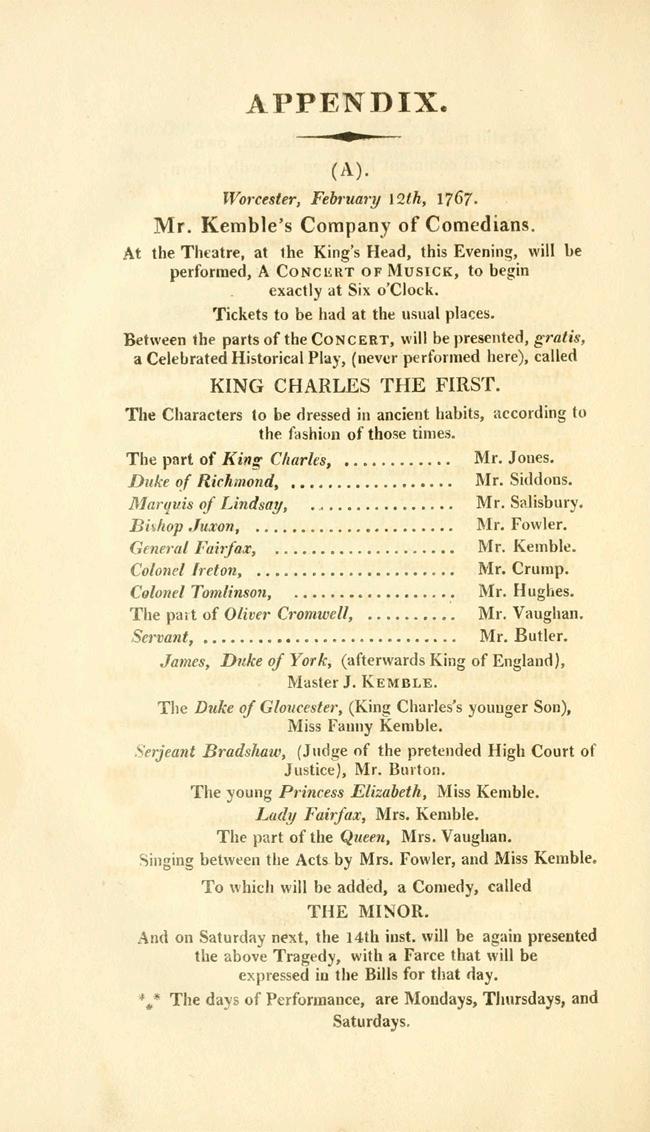
FiGURE 1 Reproduction of a playbill for 12 February 1767 documenting an early performance by Siddons and Kemble with their parents’ company in Worcester. From An Authentic Narrative of Mr. Kemble’s Retirement from the Stage (London: John Miller, 1817), 72. Digitized by the Internet Archive, original held by the University of California Libraries.
theatrical family. Roger Kemble met and married Sarah Ward while performing with her parents’ touring company in the Midlands, and he eventually took over that troupe in 1766. The siblings may have acquired their penchant for Shakespeare from their grandparents, whose company staged a fundraising performance of Othello on 9 September 1746 to restore the memorial to Shakespeare in the Holy Trinity Church, said to
be the first recorded performance of a Shakespeare play in Stratford-upon-Avon. The older Sarah Ward was the daughter of Stephen Butcher and his wife (name unknown) who were also provincial performers, and it was apparently from this side of the family that Siddons and Kemble inherited ‘their aristocratic bearing, their Roman features, and their theatrical genius’.5
Roger and Sarah Kemble had a total of twelve children (Siddons and Kemble were the eldest), all born at various locations to which their theatre company toured. The Kembles apparently did not want their offspring to take to the stage, though all of the surviving children did, and all but one married performers. To remove them from the world of the theatre, Siddons was sent to work as a lady’s maid in 1770 (primarily in an attempt to separate her from William Siddons as the Kembles did not approve of his relationship with their daughter), and Kemble was dispatched to Douai, France, to train as a Catholic priest in 1771. While both learned skills that would be important for their stage careers in these professions (aristocratic deportment for Siddons and classical declamation for Kemble), their time outside the theatrical world was short-lived. Following her marriage to William, Siddons made a name for herself among the aristocratic elite while acting at Cheltenham in the summer of 1774. Siddons encouraged Crump and Chamberlain, the managers of the provincial company with which she had been acting, to engage Kemble in early 1776, following his return from France.
Eighteenth-century Britain boasted a vibrant provincial theatre scene. Strolling companies toured regions of the country, performing in halls, inns and even barns. Roger Kemble’s troupe was one such company, acting throughout the West Midlands. These theatrical circuits allowed citizens of even relatively small towns to see performances on a regular basis. Larger towns had purpose-built performance venues and from the 1760s onwards many of these received the designation Theatre Royal, indicating that they had government approval to stage drama, and further developing and elevating regional performance. The London theatre world was also tightly
controlled. There were only three patent theatres, the Theatres Royal of Drury Lane and Covent Garden, which operated from September to June, and the Haymarket, which opened in the summer months when the two main theatres were closed. By the time that Siddons and Kemble made their names, it was common for star actors to tour the provinces over the summer, allowing audiences outside London to experience their celebrated performances and further cementing their fame. The London theatre world generally looked down on performance outside the capital, particularly that of itinerant companies, as unsophisticated. For example, Henry Bate, sent by Drury Lane manager David Garrick to observe Siddons at Cheltenham in the summer of 1775 with a view to recruiting her to act at Drury Lane, wrote of observing the actress play Rosalind in ‘a barn about three yards over and consequently under almost every disadvantage’.6 He expressed surprise that she ‘had contracted no strolling habits’, despite having ‘been up on the stage from her cradle’, instead noting the refinement of ‘her ease, figure and manner’.7 In fact, the experience Siddons and Kemble had obtained both through their many early provincial performances and by observing at first-hand the workings of touring theatre companies was crucial to their later success.
Siddons’s London debuts
Siddons’s first appearance at Drury Lane on 29 December 1775 as Portia in The Merchant of Venice was not the stuff of legend. Indeed, this great Shakespearean actress did not immediately excel in a Shakespearean role in the capital and, despite her later fame, she did not take the London theatre world by storm straightaway. At the end of the season, she was dismissed and did not appear in London again until 1782. Siddons’s personal circumstances must have made it challenging to make such an important career move at this time. She had given birth to her second child just a few weeks before and had then moved her family to London and begun rehearsing with Garrick’s
company. Furthermore, Drury Lane was very different from any of the venues in which Siddons had previously performed. It seated about 2,000 spectators, compared to the few hundred at most that the converted malt house in Cheltenham could have accommodated, and therefore necessitated a different acting technique.
Several other reasons have been posited for Siddons’s failure in this first season, and examining these gives us some sense of both her acting style and audience taste early in her career. First of all, the character of Portia was deemed an unsuitable one. The actress’s early negotiations with Garrick included a list of twenty-three roles in her command, six of which were marked as ones she favoured, including Portia, suggesting an early preference for this part.8 However, in her recollections, quoted by her biographer, Thomas Campbell, Siddons claimed, perhaps with the benefit of hindsight, that Portia was ‘a character in which it was not likely that I should excite any great sensation’.9
Another biographer, James Boaden, felt that while Siddons had Portia’s ‘taste, her sensibility, her reflecting dignity, her unexpected powers of almost masculine declamation’, the role contained ‘nothing to alarm, to excite, to fire with indignation, or subdue by tenderness’.10 Thus, as Portia, Siddons could only ‘convince the reason’, whereas the actress needed ‘to raise an interest by piercing the heart’.11 Boaden suggests that Siddons already excelled in the declamatory style for which she later became famous when performing Shakespearean heroines. He also implies not that Siddons could not move her audience but, rather, that the part chosen for her did not allow her to do so, suggesting she had also begun to make pathetic roles a central component of her repertoire. These affective parts proved enduringly popular. Such characters, generally found in the Restoration and eighteenth-century tragic repertoire, were placed in highly moving situations and generated an extremely emotional response from the audience. A further problem for Siddons was that the Drury Lane company already featured several important actresses who, in line with the theatrical tradition of the period, owned these emotive roles, thus
effectively barring the new actress from performing them. Mary Ann Yates and Elizabeth Younge were the current stars and occupied ‘all that was worth doing in tragedy and sober comedy’, whereas Frances Abington excelled in ‘the sparkling gaiety or pungent satire’ of lighter comedy.12 Siddons would have to wait until Yates and Younge left Drury Lane at the end of the 1770s in order to achieve greater prominence on the London theatre scene.
Theatre history has treated Siddons’s Portia as her debut on the London stage but in fact her first performance in the capital had occurred a few days earlier. Critical attention now tends to focus on the mainpieces acted in the period, the full-length plays that made up the bulk of an evening’s entertainment. However, theatres at this time staged a bill of performances each night which combined a mainpiece with an afterpiece – a brief, often comic play – along with other forms of entertainment (such as entr’acte songs and dances). Although afterpieces were shorter than mainpieces, they were not necessarily less important to the audience and often proved to be the most popular element of the playbill. One such afterpiece was The Jubilee, which Garrick revived on 26 December, casting Siddons as Venus, and which had many more performances that season.13 The Jubilee was a farce written by Garrick himself that both poked fun at the Shakespearean celebration that he had organized in Stratford-upon-Avon in 1769 and staged for a London audience the procession of Shakespearean characters that was rained off during the notoriously wet weekend in the Midlands. The piece culminates with the crowning of Shakespeare’s statue by Tragedy and Comedy, and a celebratory roundelay sung by assorted graces and muses, including Venus. Siddons was not chosen to embody a Shakespearean character in the pageant at the heart of The Jubilee because these parts were already identified with members of the Drury Lane company who acted them when the plays themselves were performed. The role of Venus, however, did connect Siddons with Shakespeare in the public imagination as she participated in this theatrical celebration of the dramatist.
Siddons’s only other Shakespearean role that season was as Lady Anne to Garrick’s Richard III, which she acted three times. Given her later reputation as a tragedienne, the actress might have been expected to excel in this part, but the London Magazine described her as ‘lamentable’.14 Although Siddons later struck her spectators with terror, for example as Lady Macbeth, her biographers’ claims that she was intimidated by Garrick’s ferocity as Richard are plausible given Frances Burney’s comments on a performance just a few years earlier: ‘Garrick was sublimely horrible! – Good Heaven – how he made me shudder whenever he appeared!’15 Siddons’s performance must also have been overshadowed by the fact that the celebrated Garrick was acting the character (with which he was closely identified) for the final time in his long career. The actress also created the role of Emily in Hannah Cowley’s new play The Runaway, which had a successful run of seventeen performances that season. In this play she showcased her skills in comedy, but Campbell suggests that a moment in the play in which the heroine is ‘accused of having been a strolling player’ would have been ‘mortifying’ for Siddons.16
Siddons returned to the provinces after her dismissal from Drury Lane not as a strolling player but, rather, as a member of established regional companies. She acted with Joseph Younger and George Mattocks’s company at Liverpool and Manchester and on Tate Wilkinson’s Yorkshire circuit before engaging at Bath in the autumn of 1778. It was at Bath and Bristol that she honed her craft, mastering over one hundred roles, including many that she later made famous on the London stage. When she left Bath in 1782 to return to Drury Lane (now under the management of Richard Brinsley Sheridan), she delivered a farewell speech to the audience in which she offered ‘Three Reasons – for her quitting this theatre’, bringing her three children onto the stage.17 When Siddons appeared again in London on 10 October 1782, her choice of role, the title character in the successful pathetic tragedy Isabella; or, The Fatal Marriage (written by Thomas Southerne in 1694 and adapted by Garrick in 1757), was apparently more judicious
than choosing Portia in 1775. Furthermore, Siddons’s oldest child, Henry, acted alongside her. In contrast to her earlier London debut, the actress had now begun to foreground her maternal status in performance, a strategy which contributed to her success this time around: as Campbell noted, ‘with her beautiful little son, Henry, in her hand, she looked the very personage’.18 From Boaden’s comment that in this play Siddons acted ‘with pathos that will never be excelled’, we can deduce that the problem identified with her performance of Portia – that it focused on declamation at the expense of passion – was rectified with this choice of role.19 Indeed, the rest of the actress’s parts that season were largely in the same pathetic vein. With Yates and Younge now acting at Covent Garden, Siddons was free to take up the lead female roles in the recent and contemporary repertoire that she had played in the provinces. In fact, she did not perform any Shakespearean parts in the 1782–3 season.
Siddons’s next part was Euphrasia in The Grecian Daughter (Arthur Murphy, 1772) on 28 October. In this tragedy, ‘she assumed the graces of filial piety’ rather than Isabella’s wifely obedience and showcased ‘a royal loftiness . . . and a look of majesty’ which later came to be hallmarks of her performance of some Shakespearean heroines.20 The fact that Yates was brought out at Covent Garden in the same role in a deliberately competitive move suggests that Siddons was now seen as a major threat. She then tackled the principal characters in two of Nicholas Rowe’s she-tragedies (dramas focused on the sufferings of the central female character and designed to move the audience), Jane Shore in the play of the same name (1714) on 8 November and Calista in The Fair Penitent (1702) on 29 November. Boaden recorded the powerful effect Siddons had on her spectators when she acted Jane Shore: ‘I well remember (how is it possible I should ever forget?) the sobs, the shrieks, among the tenderer part of her audiences; or those tears, which manhood, at first, struggled to suppress, but at length grew proud of indulging.’21 Campbell noted of Siddons’s Calista that ‘her success in the character was another large step in her
popularity’.22 On 14 December she played Belvidera in the perennially popular tragedy Venice Preserved (Thomas Otway, 1682). She had acted the role at Cheltenham in 1774, when a group of fashionable playgoers had attended in anticipation of ‘a treat of the ludicrous, in the misrepresentation of the piece’ by a provincial company.23 But instead of laughter, Siddons’s performance provoked such weeping in the group of playgoers ‘that they were unpresentable in the morning, and were confined to their rooms with headachs’.24 Although doubtless exaggerated, this anecdote confirms the emotional power of Siddons’s performance in this character. The actress’s ability to portray strength and pathos as Belvidera, who plays an active role in the political plot but eventually goes mad at her treatment by her husband, Jaffier, made the role a huge success for her on the London stage as well: the Morning Post went so far as to claim that ‘there did not appear a single error in her performance’.25 On 18 March 1783, Siddons tackled Zara in William Congreve’s only tragedy, The Mourning Bride (1697), another character that she had acted successfully in the regions before bringing her interpretation to the London stage. William Godwin later pronounced that ‘her magnificence in the part was inexpressible’ and ‘not inferior even to her Lady Macbeth’.26
There were a number of markers of Siddons’s success on the occasion of her reappearance at Drury Lane in 1782: a fashion apparently sprang up at that time for breakfasting near the theatre ‘in order to be among the first to queue up for seats’; visitors ‘thronged’ to see William Hamilton’s portrait of Siddons as Isabella, which also featured her son Henry, even before the painting was finished; Queen Charlotte appointed Siddons ‘reading preceptress’ to the princesses (her daughters with King George III); and she was ‘highly gratified’ by being given Garrick’s dressing room as a result of her accomplishments.27 Towards the end of the season, the Morning Herald reported on Siddons’s financial success: originally engaged by the managers at £10 per week, she was subsequently allowed ‘to fix her own terms in future’, said to
be £20 per week for the following season.28 Siddons’s major achievements were a result of both talent and hard work. She acted on half of the roughly 190 nights of performance of that season, including 22 appearances as Isabella, 14 as Jane Shore, 14 as Calista, 13 as Belvidera and 11 as Euphrasia.29
Robert Shaughnessy’s comment that ‘there could hardly have been a greater contrast between Siddons’s ignominious departure from Drury Lane in 1776 and her triumphant return there six years later’ is typical of the way in which biographers have portrayed the actress’s return to London in 1782 as the polar opposite of her ill-fated 1775 debut.30 Siddons herself characterized this second appearance as a triumph over her earlier failure, describing the ‘nervous agitation’ and ‘dreadful suspense’ she experienced before her ‘fiery trial’ and contrasting these emotions with the ‘reiterated shouts and plaudits’ with which her performance was greeted.31 Another aspect of this contrast lies in the fact that, unlike in her first London season, Siddons did not attempt any Shakespearean roles. Instead, the characters in which she triumphed were those of the Restoration and the eighteenthcentury repertoire. Campbell pronounced Southerne, Otway and Rowe, the authors of several of these dramas, as ‘entitled to our respect’ as successors of Shakespeare, and Boaden drew a link between Southerne’s Isabella and King Lear. 32 Thus, although the plays in which Siddons was successful in this second London season may seem utterly un-Shakespearean to us, perhaps eighteenth-century audiences saw a connection. Furthermore, these roles remained central to the actress’s repertoire: Isabella, Euphrasia and Belvidera were performed as part of the selection of Siddons’s best characters in her final season on the stage.
Kemble’s London debut
When John Philip Kemble made his Drury Lane debut on 30 September 1783, one year after Siddons’s return to the capital,
the London audience was well prepared for his arrival by the popularity of his older sister. According to Boaden, the actress took an active interest in promoting her brother: ‘Mrs. Siddons had, with becoming zeal, prepared her friends to welcome her elder brother; and as she had herself acted repeatedly with him, there could be no reasonable doubt of the opinion she expressed of his talents.’33 Siddons had supported her brother’s burgeoning career in the provinces, encouraging Younger and Mattocks to hire him at Liverpool and Manchester in 1777 (and apparently also bailing him out when he found himself imprisoned for debt), and her success on Tate Wilkinson’s circuit inspired the Yorkshire manager to employ Kemble in 1778 in the hope of reaping a similar financial reward from his acting.34 Just as Siddons had submitted a list of her roles to Bate to share with Garrick, Kemble sent Wilkinson a catalogue of sixty-eight tragic and fifty-eight comic parts, twenty-nine of which were marked as his favourites, demonstrating mastery of an impressively varied repertoire.35 Kemble then spent two seasons acting in Dublin and elsewhere in Ireland, appearing alongside Siddons in the summer of 1783 as he had done in Liverpool and Manchester a few years earlier. However, Kemble’s first appearance in London was in no way as sensational as Siddons’s second debut as Isabella in the preceding season: ‘The impression that he did make at first was not of the brilliant and overwhelming character which attended on his more gifted sister.’36
When Kemble stepped onto the Drury Lane stage, audiences immediately recognized the family resemblance, exclaiming ‘how very like his sister!’37 But each actor had a different impact on the audience: ‘She swept after her all hearts, passions, sympathies; he had gained admiration and intellectual interest.’38 Ultimately, ‘the advantage was with her’ and Siddons’s emphasis on passion won out over Kemble’s focus on intellect for the audience at this time.39 Kemble perhaps deliberately adopted a somewhat different style than Siddons in order to differentiate himself from his sister in an attempt to achieve success on his own terms. But the
relationship remained perceptible to spectators: in a review of his debut London performance, the Morning Chronicle pronounced Kemble ‘a true brother of Mrs. Siddons’ who ‘proves his relationship to his sister, in ability as well as in blood’ and was therefore ‘a valuable acquisition to the theatre’.40
Kemble’s debut role was Hamlet, a part which became one of the most important of his career. Boaden noted the difficulty of performing such a famous character: ‘If he agreed with his predecessors and contemporaries, it would be said that he wanted originality; if he differed essentially, in either conception or execution, he was open to the charge of selfsufficiency and presumption.’41 This is borne out by the fact that while Kemble did in fact introduce several new elements to the part, his critics derogatorily called these changes, particularly those made to the text or the actor’s interpretation of it, ‘NEW READINGS’.42 The alterations made by Kemble, including vocal delivery, physical action and costuming, will be discussed in Chapter 5 of this volume, as will Siddons’s interpretation of Hamlet. Kemble’s sensitivity to criticism of the presumptuousness of his innovations is evidenced by the fact that he originally omitted Hamlet’s advice to the players’ speech, ‘upon the modest principle, that he must first be admitted a master in the faculty, before he presumed to censure the faults of others’.43 He later restored the lines. Proof of the success of his performance is seen in the same way as with Siddons: John Henderson was brought out as Hamlet at Covent Garden in order to compete, and the rival actor in fact even adopted some of Kemble’s innovations.44 Kemble faced the same issue as Siddons in terms of access to roles because senior actors such as William Smith, John Palmer and William Brereton ‘were unwilling to give up the major parts they were accustomed to play and by tradition could not be deprived of them’.45
Like Siddons, Kemble’s other parts this season were largely non-Shakespearean. He next played the title role in Edward the Black Prince (William Shirley, 1750), a play described
as a ‘strange rhapsody of tragic shreds and patches’ from Shakespearean dramas such as Hamlet and Richard III. 46 Given his burgeoning career as a Shakespearean actor, Kemble might have been expected to succeed in such a work but, instead, he was considered uneven in the title role: ‘In the impassioned scenes he was nervous, and dignified; but in those less interesting, offensively emphatic, and monotonous.’47 This irregularity was particularly evident in his attempts to manage the emotional tone of the play, in distinction to Siddons, who was praised for the pathetic dimension of her acting. As the comic villain Sir Giles Overreach in A New Way to Pay Old Debts (Philip Massinger, c. 1625), Boaden found him inferior to Henderson: ‘He had not the bustle, the ardour, the grasp of the man; and his exultation was not so triumphant.’48 On 28 April 1784, Kemble acted Cato in Joseph Addison’s 1713 tragedy, one of the Roman roles that would become so central to his career, the most famous of which, Coriolanus, will be discussed in Chapter 2.
Kemble’s Shakespearean parts in his debut London season included Richard III, which he acted for the first time in the capital on 6 November 1783. Boaden claimed that this role improved later in Kemble’s career: ‘It had then, by no means the effect, which he subsequently gave to it.’49 Furthermore, audiences remembered ‘the dreadful energy of Garrick’ in the part that had startled Siddons several years earlier when she acted Lady Anne.50 However, Kemble’s Richard displayed ‘greater subtlety’ than his predecessors.51 He also played Shylock on 22 January 1784, and the following day the Morning Chronicle reported that he ‘was very favourably received’, further noting that, as in the other roles he had played that season, he ‘displayed a mixture of merit and extravagance, but less of the latter than in any other part we have seen him play’.52 Kemble’s ‘extravagance’ seemed to lie in the ‘new readings’ he proposed, just as he had done in Hamlet. 53 Hamlet, Richard and Shylock were parts he had played in Dublin, where, as ‘his admired sister’ had done in London, Kemble had ‘made tragedies once more the fashion’.54
In describing his success in Dublin, a critic in the Gentleman’s Magazine praised Kemble’s ability ‘to give scenes, particularly Shakspeare’s, a new and more emphatical grace than I have ever known imparted to them by any other performer’.55 Once he was able to take over the major Shakespearean roles from established London actors, Kemble would bring these skills to the capital as well.
Debuting together
Siddons and Kemble appeared together for the first time on the London stage on 22 November 1783, acting wife and husband in the lead roles of Edward Moore’s The Gamester (1753). In this affective domestic tragedy, Mrs Beverley strives to save her husband, who is essentially good though addicted to gambling, but despite her efforts Beverley eventually poisons himself in despair. Although denigrated by some critics as too bourgeois (purists still believed that tragedy should focus on the fortunes of eminent figures), The Gamester was extremely popular with playgoers because of its focus on figures drawn from everyday life and the strong emotions their situation provoked. Campbell writes of Siddons’s and Kemble’s performance that ‘their success was brilliant’ and explains that when they acted together, ‘there was a pleasing harmony in their manner, although hers was the more natural; and, side by side, they appeared the two noblest specimens that could be produced of the breed of England’.56 Although Mrs Beverley was another pathetic character ‘of fond suffering virtue’, Siddons was able to incorporate flashes of the power and grandeur for which she later became famous: Boaden describes her refutation of the nefarious Stukely’s attempts to arouse her suspicions and jealousy, in which ‘her eye . . . “flamed amazement”’.57 Kemble’s performance both showed ‘his critical judgment of the meaning of each sentence’, paying the same close attention to the text as he had done in Hamlet, and ‘gave to Beverley points of superior efficacy in stirring the bosom’, demonstrating that he
could also perform passionate roles.58 The popularity of The Gamester paved the way for the siblings’ first joint London appearance in a Shakespeare play, King John, on 10 December 1783, a production that will be discussed in Chapter 1.
Kemble chose The Countess of Salisbury (Hall Hartson, 1767), a tragedy based on Thomas Leland’s 1762 medieval romance novel Longsword, for his benefit on 13 April 1784 in order to act alongside his sister. As part of their contract, actors were accorded one benefit night per season, an evening on which they kept the night’s profits, minus the house production costs. Benefit nights were designed to showcase actors’ popularity and performers usually chose either roles in which they had already been successful or parts they had not yet attempted that would provide playgoers with some novelty, in the hope of drawing large audiences to the theatre and thereby maximizing their profits. When Siddons had appeared as the Countess of Salisbury opposite Smith on 6 March, the Morning Chronicle reported that ‘even her great acting could not keep it up from ridicule’.59 However, when she performed with her brother, Kemble’s benefit took a very respectable £290 15s.60 Siddons’s status was already so high that, unusually, she received two benefit performances each season, the first of which was ‘clear’, that is, free of house charges. In 1783–4, for her first benefit Siddons played Lady Randolph in John Home’s tragedy Douglas (1756) on 22 December 1783. This choice of role was perceived as a direct challenge to one of her rivals, Ann Crawford (formerly Barry). Siddons excelled in depicting the character’s maternal grief and the receipts for the performance were £303 8s. 6d. For her second benefit on 24 April 1784, she chose a drama in which Kemble could appear alongside her, Tancred and Sigismunda (James Thomson, 1745). In this tragedy, Siddons played a character torn between a sense of duty to her father and her love for Tancred. The New Spectator pronounced that the siblings played the lead roles ‘with such happiness of expression, as to leave few, if any, dry eyes in the house’.61 The performance earned £324 1s., the highest amount taken
for a benefit at Drury Lane that season. While Boaden and Campbell felt that The Countess of Salisbury and Tancred and Sigismunda were beneath the actors, especially Siddons, these were roles that Siddons and Kemble had played to great acclaim outside London earlier in their careers.62 Siddons had acted both the Countess and Sigismunda at Bath and had performed the latter role even earlier, at Manchester in 1778. When The Countess of Salibsury was advertised for Kemble’s benefit night, the press noted that ‘those who have seen Mr. Kemble at York and in Dublin, speak of his Earl Alwin as a very capital performance’.63 It is notable that both actors decided to appear together for their benefits this season, suggesting that they believed the power of a joint performance would be a draw for playgoers and would earn them more money. As we have seen, the Drury Lane accounts demonstrate that this was the case. Acting together was an important foundation for Siddons and Kemble, as I will explore further in the next chapter.
